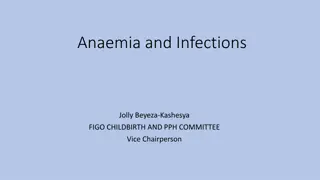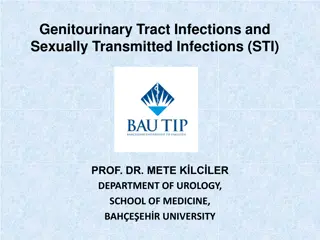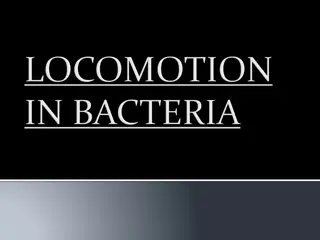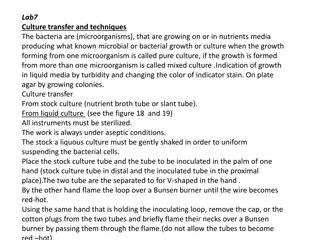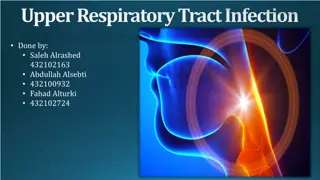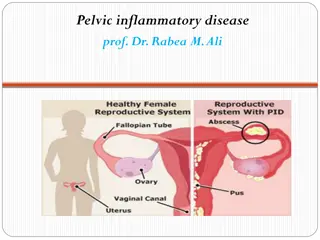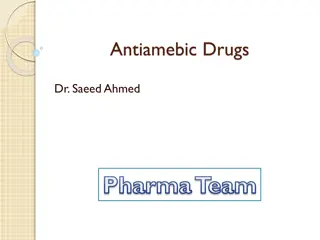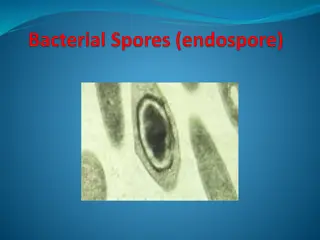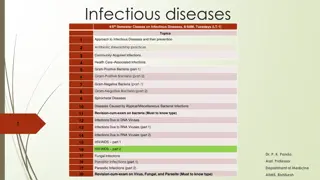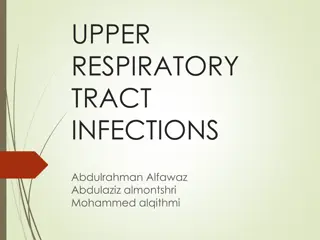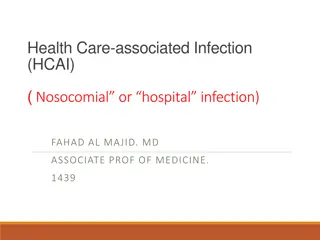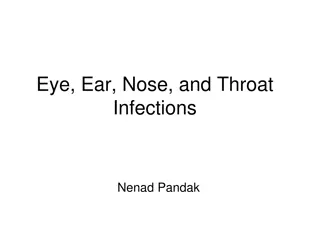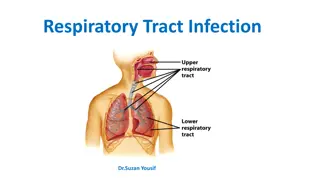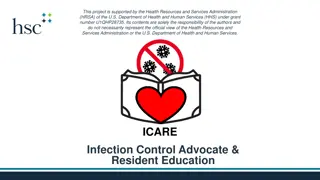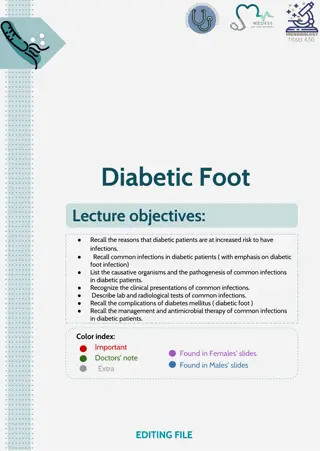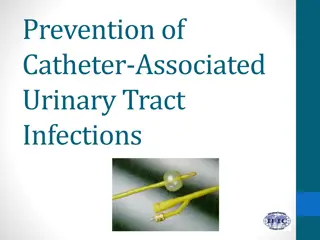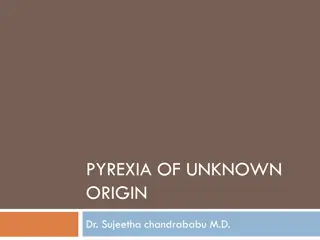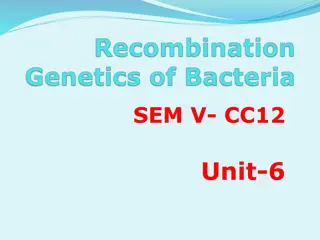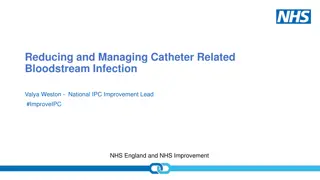Understanding Anaemia and Infections in Relation to Health
Anaemia can result from various causes such as blood loss, increased destruction of red blood cells, and impaired production, often linked to infections and chronic diseases. Parasites, bacteria, and viruses play a role in the progression of anaemia, affecting the body's ability to produce and utili
3 views • 10 slides
Understanding Nontuberculous Mycobacteria Infections in Cystic Fibrosis
Nontuberculous mycobacteria (NTM) infections present a significant challenge in individuals with cystic fibrosis (CF). These infections are caused by over 200 species of atypical mycobacteria found in various environments. The CF-ID Clinic plays a crucial role in managing patients with multi-drug re
2 views • 25 slides
Understanding Bacterial Toxins and Cell Damage
Bacterial toxins are poisonous substances produced by microbes that can cause harm to host cells through direct damage, toxin production, and hypersensitivity reactions. Toxigenesis is a crucial mechanism used by bacterial pathogens to induce disease, with endotoxins and exotoxins playing distinct r
2 views • 28 slides
Anaerobic Bacterial Infections: Overview and Clinical Implications
Anaerobic bacterial infections are caused by bacteria that do not require oxygen for growth, posing challenges in diagnosis and treatment. This article delves into the types of anaerobic bacteria, their role in human infections, and common clinical presentations such as abscess formation. Gram-negat
2 views • 24 slides
Overview of Genitourinary Tract Infections and STIs by Prof. Dr. Mete Kılcıler
Genitourinary Tract Infections and Sexually Transmitted Infections (STIs) are common conditions affecting both men and women. This article, presented by Prof. Dr. Mete Kılcıler from the Department of Urology at Bahçeşehir University School of Medicine, delves into the various aspects of UTIs, in
2 views • 47 slides
Understanding Bacterial Physiology and Growth
Bacterial physiology encompasses the growth, nutrition, and metabolism of bacteria. Bacterial growth involves binary fission, generation time, colony formation, and is influenced by various factors such as temperature, atmosphere, moisture, and radiation. Understanding the classification based on te
0 views • 33 slides
Exploring Bacterial Flagella: Structure and Function
Bacterial flagella are long, thin appendages crucial for motility in bacteria. Composed of filament, basal body, and hook, these structures play a vital role in bacterial movement. This article dives into the detailed structure and functionality of bacterial flagella, highlighting their importance i
0 views • 9 slides
Understanding Bacterial Locomotion: Flagellar Structure and Movement Mechanism
Bacterial locomotion involves intricate flagellar structures composed of filaments, basal bodies, and hooks. The synthesis of flagella is a complex process controlled by numerous genes. The rotation of the flagellar helix acts as a motor, determining the direction of bacterial movement.
1 views • 12 slides
Understanding Bacterial Photosynthesis: Types and Processes
Photosynthesis is the conversion of light energy into chemical energy, crucial for growth and production of ATP. Prokaryotes such as cyanobacteria, purple and green bacteria, and halobacteria demonstrate different forms of photosynthesis. Oxygenic photosynthesis, found in cyanobacteria, releases oxy
2 views • 20 slides
Introduction to Phage DNA Integration in Bacterial Cells
Phage DNA can be introduced into bacterial cells through two methods: transfection and in vitro packaging. Transfection involves mixing purified phage DNA with competent E. coli cells, inducing DNA uptake via heat shock. In vitro packaging utilizes proteins coded by the phage genome, which can be pr
1 views • 13 slides
Bacterial Culture Transfer Techniques and Growth Indicators
Bacterial cultures can be transferred using aseptic techniques to ensure purity. Growth indicators such as turbidity in liquid media and colonies on agar plates signify microbial growth. Proper sterilization and handling of instruments are crucial in the process. Techniques like streaking on agar pl
1 views • 4 slides
Differentiating between Viral and Bacterial Infections in Upper Respiratory Tract
Understanding the distinction between viral and bacterial upper respiratory tract infections is crucial for effective management and treatment. This article discusses key differences in symptoms, diagnostic methods, and treatment approaches to aid in accurate differentiation between the two types of
2 views • 87 slides
Understanding Fungi Diversity and Infections in Microbiology
Explore the world of fungi and fungal infections in this foundation block of microbiology. Learn about medically important yeasts, mold fungi, major fungal diseases, antifungal agents, and infection acquisition methods. Dive into hypersensitivity reactions, mycotoxicoses, and various types of fungal
1 views • 19 slides
Understanding Female Reproductive Infections and Inflammations
Female reproductive system infections such as Pelvic Inflammatory Disease (PID), Vaginitis, Cervicitis, Endometritis, and Salpingitis can lead to various symptoms and complications. These conditions are caused by different factors including infections, bacterial imbalances, and sexually transmitted
0 views • 44 slides
Understanding Virus-Cell Interactions and Infections
Viral infections exhibit diverse cellular tropism based on receptor interactions, impacting cell function through modulation and potential host defense responses. Infections can lead to various outcomes, from cell death to persistent or latent states, with nuanced effects on cellular behavior. Diffe
0 views • 8 slides
Understanding Antiamebic Drugs: A Guide to Managing Protozoal Infections
Protozoal infections, such as amebiasis, are a significant concern globally. In underdeveloped regions and beyond, these infections pose challenges due to inadequate sanitation and hygiene practices. Antiamebic drugs are essential for treating conditions like amebiasis, caused by Entamoeba histolyti
0 views • 40 slides
Understanding Bacterial Spore Survival and Thermal Death Rates
Survival of bacterial spores during heat processing is crucial for food safety. The concept of Decimal Reduction Time (D value) and Thermal Death Time (TDT) curve help in understanding the thermal destruction of bacteria or spores. The Z value indicates the change in temperature necessary to cause a
6 views • 14 slides
Understanding Anthelmintics: Drug Therapy for Parasitic Worm Infections in Veterinary Medicine
Anthelmintics are essential drugs to combat parasitic worm infections in animals. They work either by killing (vermicide) or expelling (vermifuge) the worms, reducing worm burdens and controlling infections. This comprehensive overview covers different aspects of anthelmintics, including their prope
2 views • 34 slides
Understanding Bacterial Endospores and Sporulation Process
Bacterial endospores are dormant structures that allow bacteria to survive harsh conditions. They contain vital genetic material and are resistant to drought, heat, radiation, and chemicals. The process of sporulation involves the formation of endospores within bacterial cells, followed by germinati
0 views • 34 slides
Understanding the Treatment of Respiratory Tract Infections: Antibiotics and Management
This lecture covers the classification of respiratory tract infections and the antibiotics commonly used to treat them. It highlights the types of infections caused by viruses and bacteria, along with their respective treatments. The mechanism of action and pharmacokinetics of antibiotics, such as p
0 views • 7 slides
Understanding Urinary Tract Infections During Pregnancy
Urinary tract infections are common bacterial infections during pregnancy, with asymptomatic bacteriuria being prevalent. If left untreated, asymptomatic bacteriuria can lead to symptomatic infection, but proper treatment with antimicrobial agents can prevent complications. Treatment options include
3 views • 26 slides
Infectious Diseases 4/5th Semester Classes: Approach & Prevention
Infectious Diseases class focuses on various topics including Antibiotic Stewardship Practices, Community-Acquired Infections, Gram-Positive and Gram-Negative Bacteria, Spirochetal Diseases, Diseases Caused by Bacterial and Viral Infections, HIV/AIDS, Fungal and Parasitic Infections. The class also
3 views • 30 slides
Approach to Infectious Diseases: Antibiotic Stewardship, Bacterial Infections, and HIV/AIDS Clinical Staging
In the 4th-5th semester classes on infectious diseases, topics such as antibiotic stewardship, community-acquired infections, and various bacterial diseases are covered. The clinical manifestations and WHO clinical staging of HIV/AIDS for adults and adolescents are also discussed in detail. The cour
0 views • 29 slides
Understanding Bacterial Taxonomy and Staining Techniques
Bacterial taxonomy involves classifying and identifying bacteria, while staining techniques such as Gram staining help differentiate between Gram-positive and Gram-negative bacteria. This article discusses the importance of distinguishing bacterial strains, preparing smears, and performing different
0 views • 17 slides
Upper Respiratory Tract Infections: Clinical Features and Management
This presentation covers the differentiation between viral and bacterial infections, clinical features and management of sore throat, sinusitis including allergic rhinitis, otitis media in children, and modifying help-seeking behavior in patients with flu illness. Pre-test questions are also include
0 views • 75 slides
Mechanisms and Role of Horizontally Transferred Genetic Elements in Bacterial Disease Pathogenesis
This presentation explores the transfer of foreign DNA into bacteria, discussing mechanisms such as conjugation, transduction, and transformation. It delves into the significance of Mobile Genetic Elements (MGEs) like plasmids, bacteriophages, and transposons in bacterial virulence and pathogenesis.
0 views • 20 slides
Understanding Health Care-associated Infections (HCAI) in Hospital Settings
Health care-associated infections (HCAI), also known as nosocomial or hospital infections, are infections that occur in patients during their hospital stay or after discharge. These infections can result from various sources, including colonization by microorganisms and exposure to contaminated envi
0 views • 48 slides
Understanding Bacterial Morphology and Simple Stain Techniques
Explore the characteristics of bacteria based on their shape and structure, grouped into spherical, rod-shaped, and helical types. Learn about bacterial smear preparation principles and the simple stain procedure for observing bacterial cells under a microscope. Discover various bacterial species an
0 views • 13 slides
Overview of Eye, Ear, Nose, and Throat Infections by Nenad Pandak
In this comprehensive guide by Nenad Pandak, various aspects of eye, ear, nose, and throat infections are discussed. The content covers infections such as conjunctivitis, keratitis, pharyngitis, otitis media, and sinusitis. It also delves into causes, clinical presentations, and diagnosis of these i
0 views • 68 slides
Understanding Antibiotics and Their Effects on Germs
Explore the world of antibiotics and their impact on bacteria, fungi, viruses, and mild bacterial infections. Delve into the chemistry of antibiotics, their mechanisms, and how they combat various germs. Learn about the treatments involving antibodies and specific conditions like Helicobacter pylori
0 views • 18 slides
Understanding Respiratory Tract Infections: Causes and Prevention
Respiratory tract infections are commonly caused by viruses, bacteria, rickettsia, and fungi, leading to various health issues. These infections can be transmitted through droplets, droplet nuclei, and dust, emphasizing the importance of maintaining respiratory health through specific and non-specif
0 views • 34 slides
Understanding Viral Infections of the Respiratory System
Respiratory viral infections are common and primarily caused by viruses, leading to morbidity and time off work. They can range from mild upper respiratory tract infections to severe lower respiratory tract infections like pneumonia. Various viruses like influenza, parainfluenza, respiratory syncyti
0 views • 23 slides
Understanding Infectious Diseases: Approach, Prevention, and Viral Agents
Infectious diseases play a significant role in public health, with a focus on antibiotic stewardship, community-acquired and healthcare-associated infections, as well as various bacterial, viral, fungal, and parasitic agents. Specific topics include the prevention of infectious diseases, with a deta
0 views • 18 slides
Understanding Common Infections in Nursing Home Residents
Explore the causes, types, and impact of infections in nursing home residents while learning how to prevent and control infections. Discover common infections, factors contributing to infections, and resident rights in infection control practices.
0 views • 23 slides
COMBACTE-CARE: Combatting Bacterial Resistance in Europe - Study Overview
A Phase III study comparing the efficacy, safety, and tolerability of aztreonam avibactam (ATM-AVI) and meropenem colistin (MER-COL) for treating serious infections caused by Gram-negative bacteria, including MBL-producing pathogens. Approximately 300 patients with complicated intra-abdominal infect
0 views • 9 slides
Understanding Diabetic Foot Infections and Associated Risks
Diabetic patients are prone to infections, significantly impacting morbidity and mortality rates. Increased infection risk is due to both host-related and organism-related factors. Common infections in diabetic patients include skin and soft tissue infections, diabetic foot infections, respiratory t
0 views • 14 slides
Preventing Catheter-Associated Urinary Tract Infections
This presentation covers the prevention of catheter-associated urinary tract infections (CAUTIs) in healthcare settings. It highlights the significance of urinary tract infections, risk factors, preventive measures, and common microbiology involved. Key topics include the importance of urine collect
0 views • 34 slides
Understanding Pyrexia of Unknown Origin: Causes and Classification
Pyrexia of unknown origin (PUO) is a challenging diagnostic scenario characterized by persistent fever without an identified cause. Dr. Sujeetha Chandrababu M.D. defined PUO as temperatures exceeding 38.3°C for several weeks with no definitive diagnosis. Classification of PUO includes various categ
0 views • 43 slides
Bacterial Conjugation: Mechanism and Applications
Bacterial conjugation is the process of transferring genetic material between bacterial cells through direct contact or bridge-like connections. Discovered in 1946, this mechanism enables the transfer of DNA regions between various bacterial species, including Gram-negative and Gram-positive bacteri
0 views • 58 slides
Managing Catheter-Related Bloodstream Infections in Vascular Access
Reduce and prevent catheter-related bloodstream infections in vascular access by addressing extraluminal infection sources and implementing strategies outlined in national drivers such as the NHS Long Term Plan and the Antimicrobial Resistance Action Plan. Recognize the importance of tackling antimi
0 views • 25 slides
